
Sending Data by E-Mail/Saving Data to a Shared Folder
This section describes the procedures for scanning originals and sending the scanned data directly from the machine by attaching it to an e-mail or saving it to a shared folder.
 |
Before you can send the data directly by e-mail, you need to complete certain procedures, such as specifying the e-mail server settings. Procedure for Setting to Send E-Mail Before you can save the data to a shared folder, you need to complete certain procedures, such as specifying the location to save the scanned originals to. Procedure for Setting a Shared Folder as a Save Location |
1
Place the original(s). Placing Originals
2
Select <Scan> in the Home screen. Home Screen
3
Select <E-Mail> or <File>.
4
Specify the destination.
If you selected <File> in step 3, the Address Book screen is displayed. You can also specify the destination from coded dial numbers or one-touch dial numbers.
Specifying from Address Book
Specifying from Coded Dial Numbers
Specifying from One-Touch
Entering Destinations Directly (E-Mail Sending)
Specifying from Address Book
 | The Address Book enables you to specify a destination by selecting from a list of registered destinations or by searching by name for destinations with recipient names. |
 |
You need to register destinations in the Address Book before using this feature. Registering Destinations Register the shared folder address from a computer. Setting a Shared Folder as a Save Location Registering Destinations from Remote UI |
1
Select <Destination>  <Specify from Address Book>.
<Specify from Address Book>.
 <Specify from Address Book>.
<Specify from Address Book>.If the <Type> screen appears, select <To>, <Cc>, or <Bcc> as a destination type.
2
Select an index. Index

3
Select a destination.

If you want to specify multiple destinations (e-mail)
Repeat steps 1 to 3.
 |
If a destination is selected from <Addr. Book> in the Home screen, settings for e-mail sending or file saving can be made while the selected destination remains specified. |
Back to Top
Specifying from Coded Dial Numbers
 | Three-digit numbers (coded dial numbers) are assigned to addresses in the Address Book. You can specify an address simply by entering its coded dial number. |
 |
To use coded dial numbers, the destination must be registered in the Address Book beforehand. Registering Destinations Register the shared folder address from a computer. Setting a Shared Folder as a Save Location Registering Destinations from Remote UI |
1
Select <Destination>  <Specify from Coded Dial>.
<Specify from Coded Dial>.
 <Specify from Coded Dial>.
<Specify from Coded Dial>.If the <Type> screen appears, select <To>, <Cc>, or <Bcc> as a destination type.
2
Enter a three-digit number.
If you have entered an incorrect value, use  to clear it.
to clear it.
 to clear it.
to clear it.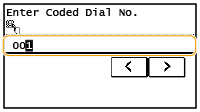

If a confirmation screen appears
When <One-Touch/Coded Dial TX Confirmation> is set to <On>, a screen is displayed that shows the destination and the name for the number. (For Group Dial, the destination name and the number of destinations are shown.) Check the contents and if everything is correct, select <OK>. To specify a different destination, select <Cancel> and then re-enter the three-digit coded dial number. Displaying Destinations in Address Book
If you want to specify multiple destinations (e-mail)
Repeat steps 1 to 2.
Back to Top
Specifying from One-Touch
 | Specify a destination by selecting from a list registered to the one-touch buttons. |
 |
You need to register destinations before using one-touch dialing. Registering Destinations in the Address Book |
1
Select <Destination>  <Specify from One-Touch>.
<Specify from One-Touch>.
 <Specify from One-Touch>.
<Specify from One-Touch>.2
Select a destination.

If a confirmation screen appears
When <One-Touch/Coded Dial TX Confirmation> is set to <On>, a screen is displayed that shows the destination and destination name registered to the one-touch button. (For Group Dial, the group name and the number of destinations are shown). Check the contents and if everything is correct, select <OK>. To specify a different destination, select <Cancel> and then select the one-touch buttons again.
 |
If a destination is selected from any of <One-Touch 1> to <One-Touch 4> in the Home screen, settings for sending e-mail or saving files can be made while the selected destination remains specified. |
Back to Top
Entering Destinations Directly (E-Mail Sending)
For a destination that is not registered in the Address Book, specify it by entering an e-mail address.
1
Select <Destination>  <Specify Using Numeric Keys>.
<Specify Using Numeric Keys>.
 <Specify Using Numeric Keys>.
<Specify Using Numeric Keys>.2
Enter the e-mail address, and select <Apply>.
On how to enter text, see Entering Text.
Back to Top

Specifying destinations from the transmission records
You can also recall previously used destinations. Recalling Previously Used Settings for Sending/Saving (Recall Settings)
Saving the data to a shared folder
Only one destination can be specified.
5
When sending an e-mail, specify multiple destinations, including Cc/Bcc destinations, as necessary.
Select <Destination>, and select the method for specifying destinations.

<Cc> and <Bcc> addresses can only be selected using <Specify from Address Book>, <Specify from Coded Dial> or <Specify from One-Touch>.
 To delete destinations
To delete destinations
If you specified multiple destinations, you can delete destinations as necessary.
1 | Select <Destination>  <Confirm/Edit>. <Confirm/Edit>. |
2 | Select a destination you want to delete. If you specified Group Dial, "XX destination(s)" is displayed. Selecting <Number of Destinations> displays destinations registered in the group. |
3 | Select <Remove>  <Yes>. <Yes>. |
6
Specify the scanning settings as necessary.
Specifying the Scanning Size of the Original
Specifying the Color Mode
Selecting a File Format
Specifying Orientation of Your Original
Scanning 2-Sided Originals
Specifying the Scanning Size of the Original
 | You can specify the scanning size of your original. |
<Scan Size>  Select the original size
Select the original size
 Select the original size
Select the original sizeBack to Top
Specifying the Color Mode
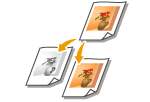 | You can specify whether to scan documents in color or black and white. |
<Color Mode>  Select the color mode
Select the color mode
 Select the color mode
Select the color modeBack to Top
Selecting a File Format
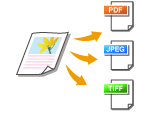 | You can select the file format to which originals are scanned from PDF/JPEG/TIFF. For PDF, you can select Compact PDF that reduces the data size. |
<File Format>  Select a file format
Select a file format
 Select a file format
Select a file format |
If you select JPEG in <File Format> and try to scan an original from the platen glass, you can only scan one page. To scan a multiple-page original all at once, use the feeder. Each page of the original is saved as a separate file. If you select TIFF or PDF, you can scan multiple-page originals either from the platen glass or from the feeder. <PDF (Compact)> compress photos and illustrations on originals more than <PDF>. The file will be smaller, but the image quality of some originals or the number of originals that can be scanned at once may be lower. |
Back to Top
Specifying Orientation of Your Original
 | You can specify portrait or landscape orientation. |
<Original Orientation>  Select the original orientation
Select the original orientation
 Select the original orientation
Select the original orientationBack to Top
Scanning 2-Sided Originals
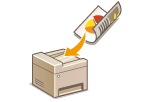 | The machine can automatically scan the front and back sides of originals in the feeder. |
 |
The machine cannot scan both sides of originals automatically when the originals are placed on the platen glass. |
<2-Sided Original>  Select <Book Type> or <Calendar Type>
Select <Book Type> or <Calendar Type>
 Select <Book Type> or <Calendar Type>
Select <Book Type> or <Calendar Type>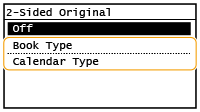
<Book Type>
Select for originals whose images on the front and back sides face the same direction.
Select for originals whose images on the front and back sides face the same direction.
<Calendar Type>
Select for originals whose images on the front and back sides face in opposite directions.
Select for originals whose images on the front and back sides face in opposite directions.
Back to Top

For information about other scan settings, see Scanning Clearly or Adjusting Balance between File Size and Image Quality.
For e-mail, you can specify the subject, message, reply-to address, and priority as necessary. Specifying E-Mail Settings
7
Press  .
.
 .
.Scanning of the original starts.
If you want to cancel, select <Cancel>  <Yes>. Canceling Sending Documents
<Yes>. Canceling Sending Documents
 <Yes>. Canceling Sending Documents
<Yes>. Canceling Sending Documents When placing originals in the feeder in step 1
When placing originals in the feeder in step 1
When scanning is complete, the sending/saving process starts.
 When placing originals on the platen glass in step 1
When placing originals on the platen glass in step 1
When scanning is complete, follow the procedure below (except if you selected JPEG as a file format).
1 | If there are additional pages of originals to be scanned, place the next original on the platen glass, and press  . .Repeat this step until you finish scanning all of the pages. When there is only one page to be scanned, proceed to the next step. |
2 | Select <Start TX>. The sending/saving process starts. |

File name of the sent document
The file name of a sent document is automatically assigned based on the following format: communication management number (four digits)_sent date and time_document number (three digits).file extension name.
If an E-Mail Send Error Occurs
Error notifications are sometimes sent to the e-mail address set to the machine. If you leave it as-is, it may result in an insufficient remaining capacity of mailbox depending on your mail server. It is recommended that you clear the mailbox periodically.
 To clear the mailbox
To clear the mailbox

When the mailbox is cleared, all e-mail in the server mailbox is deleted. When you specify the e-mail account that you use usually, you should first check whether any e-mail in the mailbox needs to be kept.
1 | Start the Remote UI and log in to System Manager Mode. Starting Remote UI |
2 | Click [Settings/Registration] on the Portal page. Remote UI Screen |
3 | Select [Network Settings]  [E-Mail Settings]. [E-Mail Settings]. |
4 | Click [Clear] in [Clear Mail Box]. |
5 | Read the message that is displayed, and click [OK]. E-mail is deleted from the mailbox. |
 |
If you always want to scan with the same settings: Changing the Default Settings for Functions |